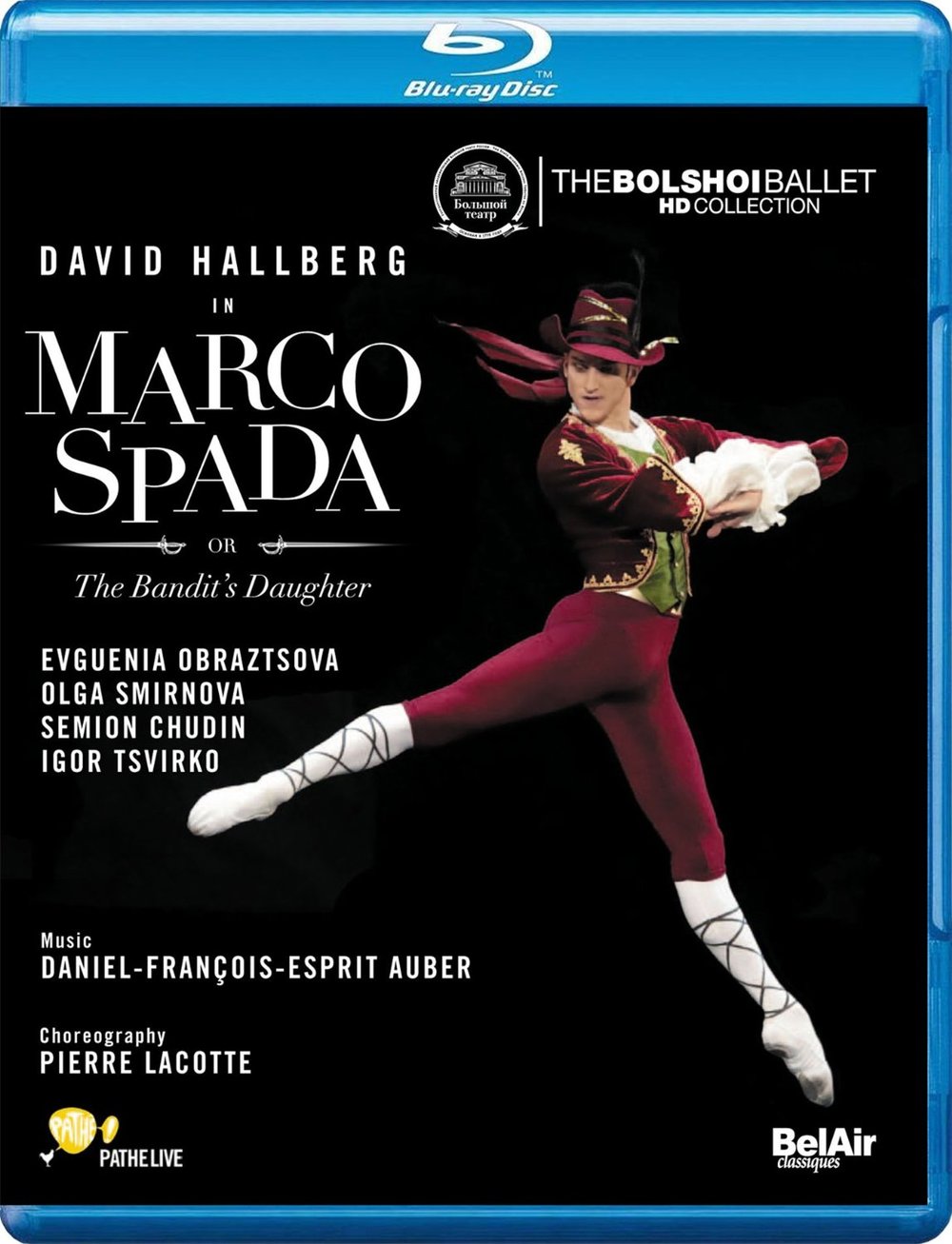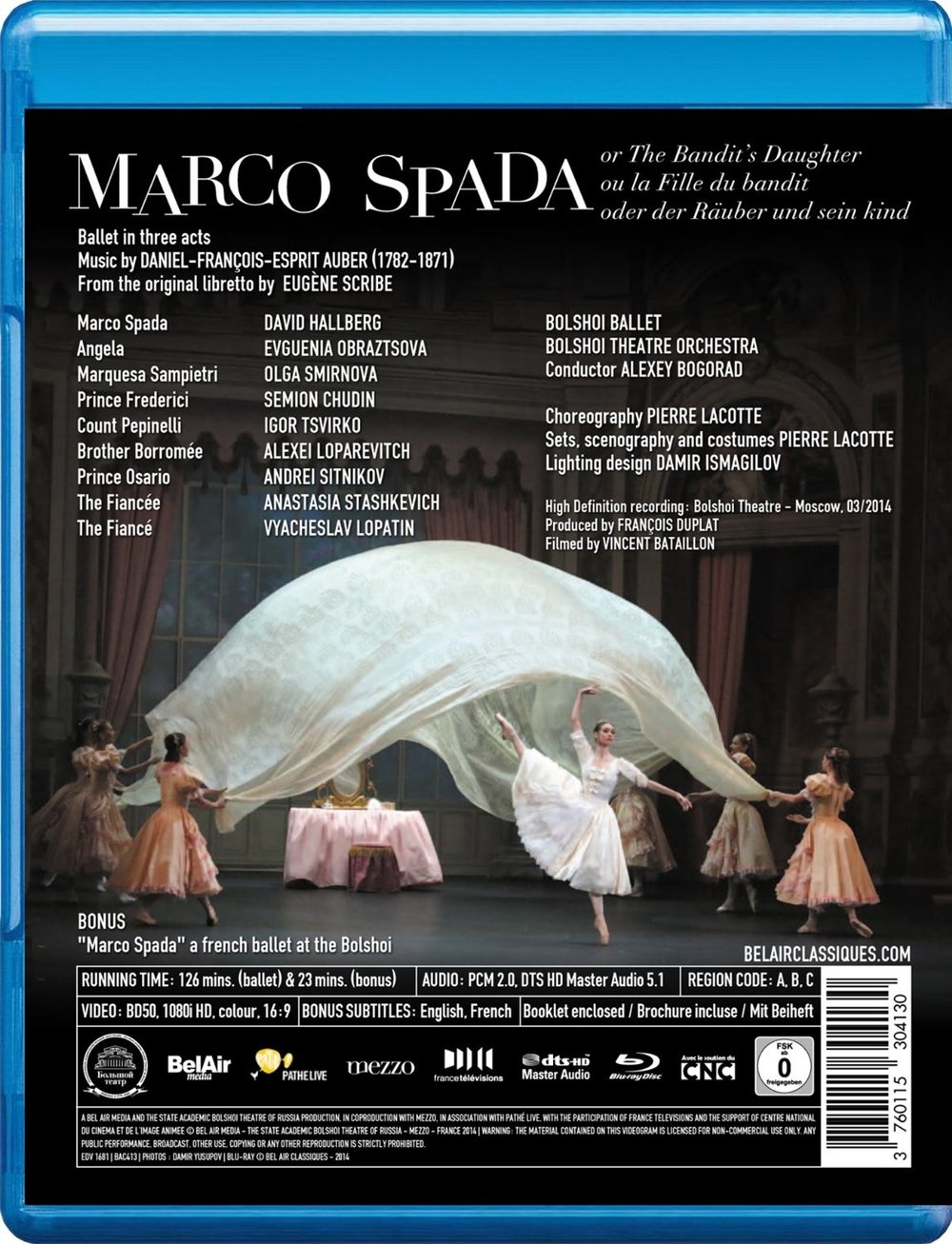

Marco Spada or The Bandit's Daughter ballet. Music by Daniel-François-Esprit Auber. Original libretto by Eugène Scribe. Choreographed and directed 2014 by Pierre Lacotte at the Bolshoi Ballet. Stars David Hallberg (Marco Spada), Evguenia Obraztsova (Angela), Olga Smirnova, (Marquesa Sampietri), Semion Chudin (Prince Federici), Igor Tsvirko (Count Pepinelli), Alexeï Loparevitch (Brother Borromée), Andreï Sitnikov (Prince Osario, Governor of Rome), Anastasia Stashkevich (The Peasant Fiancée), and Vyacheslav Lopatin (The Peasant Fiancé). Alexey Bogorad conducts the Bolshoi Theatre Orchestra. Sets, scenography, and costumes by Pierre Lacotte; lighting design by Damir Ismagilov. Directed for TV by Vincent Bataillon; produced by François Duplat. Released 2014, disc has 5.1 dts-HD Master Audio sound. Grade: A+
Marco Spada or The Bandit's Daughter is an example of an almost unknown artwork that can now be given the attention it deserves via HDVD. First produced in 1857 in Paris, Marco Spada soon fell out of repertory. It was revived in 1981 in Paris by Pierre Lacotte (then age 49) who was lucky enough to get Nureyev (then age 43) to dance the role of Marco. The piece was then apparently all but forgotten (except by Lacotte) for another 3 decades. The reason for the disinterest doubtless was the ballet's thinner-than-onion-skin plot (with zero intellectual significance) exacerbated by the fact that to mount it requires 5 star dancers plus a huge investment in stagecraft and corps dancers.
But Lacotte kept the faith looking for someone to do Marco Spada again. At age 80, he found his angel: the Bolshoi. Just finishing their billion-dollar building renovation and armed with their direct access to the Treasury of Russia, the Bolshoi management needed a way to play the hero (by saving a French masterpiece) while putting on a show that nobody else in the world could afford to do. They took a chance on Lacotte, who responded by staying alive and directing something unforgettable. And now that we have the delightful HDVD reviewed here, ballet fans all over the world will be able to enjoy it. Before we describe the production, here's a shot of the renovated interior of the theater:
Marco Spada takes place in Italy. Below is the first of 5 major sets designed by Lacotte. We are in a village near Rome. The Governor of Rome is visiting with his daughter (in mint green) and her maid servants (in gray). The peasants pray to the Governor to do something about a bandit, Marco Spada, who plagues the land:
The Governor (Andreï Sitnikov) is doing his best. The sign says (my best effort) "Reward promised for Marco Spada":
The Governor's daughter is the Marchesa Sampietri (Olga Smirnova). She is already more or less promised to another, but she is also friendly with the Army Commander Count Pepinelli (Igor Tsvirko) who has the advantage of often being around her. Pepinelli is hopelessly in love with the Marchesa:
Lacotte comes up with all kinds of dance moves I never saw before. Here the Marchesa remains rigid and the Count pushes her up (like a lever) to make a charming impression:
This ballet has no less than 6 extensive pas de deux scenes. The first one is performed by a peasant bride (Anastasia Stashkevich) and her groom (Vyacheslav Lopatin):
They start their honeymoon in fine style with a donkey cart:
Now its time for Pepinelli to continue his pursuit of the Marchesa:
Brother Borromée (Alexeï Loparevitch) has had a good day collecting alms. This has attracted the attention of Marco Spada (David Hallberg). Spada prefers to pick pockets and steal jewels by slight of hand, but sometimes brute force is needed. Still, Spada is an ethical and good-hearted thief. He will not rob a praying man, even if it tries his patience. Nobody in the village knows what Spada looks like, so he has the element of surprise. Soon he will have all the money collected by Brother Borromée:
The scene shifts to the mansion of Marco Spada, who pretends to be an honorable nobleman. This beautiful set has a number of surprises for the viewer including living statutes and servants dressed as shepherdesses and Greek muses. The real nobles find themselves at Spada's mansion when they get lost in the woods:
Prince Federici (Semion Chudin) arrives. He is the man promised to the Marchesa. But he soon meets and is smitten by Angela, Spada's daughter:
Here's daughter Angela (Evguenia Obraztsova). Now you may recall this ballet is also called The Bandit's Daughter. Angela has no idea that her father is a criminal and that all his wealth was stolen from others:
The visit of the nobles to Spada's mansion goes well. Spada and Angela are invited to a ball at the Governor's palace in Rome. So now we have yet another and even more magnificent set. Everyone wears white wigs, which makes them look alike. In this screenshot, Spada and Angela have just made their entrance on your far right:
Here's a pas de deux with the Marchesa and Federici. Lacotte likes to pose dancers with their backs to the audience. This is a daring move that gets immediate attention. I think conventional wisdom would consider this a mistake, but Lacotte pulls it off well:
A dance of the harlequins:
Later at the Governor's party, Angela learns that her father is the infamous bandit (the sign says "Marco Spada):
Suddenly life is churning for poor Angela. She can't marry Prince Federici because her father is a thief. But she loves her father so much that she will forget the Prince. She and Marco flee the Governor's ball before the army can arrive:
Now we see the boudoir of the Marchesa. The Bolshoi built and furnished this gorgeous set for a scene that lasts about 8 minutes! Note that behind the windows there is another set showing a garden:
Poor Pepinelli visits the Marchesa to make one last desperate effort to win her over. He doesn't know that she has already decided to marry him (and not Prince Federici) and has put on her white wedding dress to receive him. The servant girls (who are all sweet on Pepinelli) revel in seeing him pour out his heart --- they know he will be rewarded:
When Pepinelli gets the answer he seeks, he collapses from joy. The servant girls are there to comfort him. It's hard to convey in words or in still pictures how precious all this is — you have to get the video!
But suddenly, Spada's bandits arrive and abduct both the Marchesa and Pepinelli!
Now we see the 5th set Lacotte got for this show---the bandits' lair:
In the old days, audiences at the opera and ballet were noisier than today. They would cheer and clap enough to stop the show and demand repeats! You may also know that David Hallberg is an American dancer who whose hiring by Bolshoi director Sergei Filin was controversial in Moscow. Later, Filin was gravely injured when someone threw acid in his face. There were suggestion that the assault might have been connected to Filin's "westernization" of the Bolshoi. Well, the audience here was on Hallberg's side. By my count the audience burst into applause and rhythmic clapping (even clapping along with the orchestra) at least 50 times. This had to be exciting for the dancers, and I think you can see that excitement in this shot of a Hallberg solo:
Marco Spada wanted a better life for his daughter than that of a brigand. But now Angela begs to become part of the bandit army:
Spada kidnapped the Marchesa and Pepinelli in order to force them to marry. Then the Marchesa could no longer compete with Angela for the attention of Prince Federici. But luck is with Spada---the Marchesa and Pepinelli want to be married. And we learn that this set has two decks! But there is still one problem left. How can the bandit's daughter marry a Prince? There is a way, but I'll not spoil that part for you.
The music for this ballet is not in the same league as the Tchaikovsky scores; but it's in the same vein as, say, the music to Giselle. The orchestra plays well and is well recorded. You can see from my screenshots the brilliance of the sets and costumes. What is harder to judge is the quality of the choreography, the personal directing, and the acting. I'll vouch for all that. This show reminds me of the La Scala Raymonda. The story is a bit weak, but you could hardly imagine how the execution could be better. Finally, the videography by Vincent Bataillon is outstanding. Grade: "A+."
OR





























